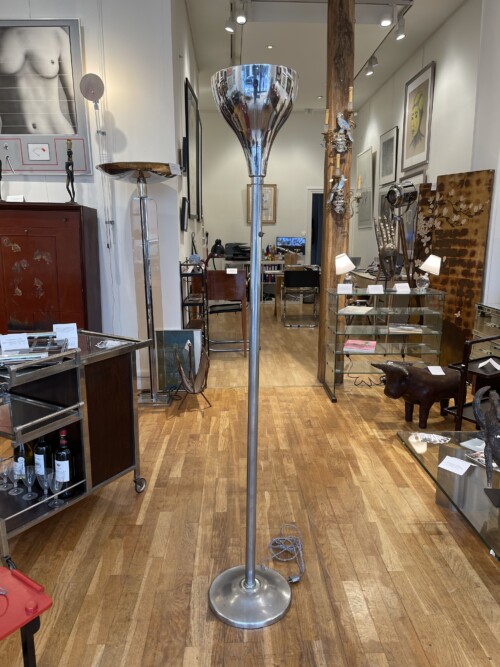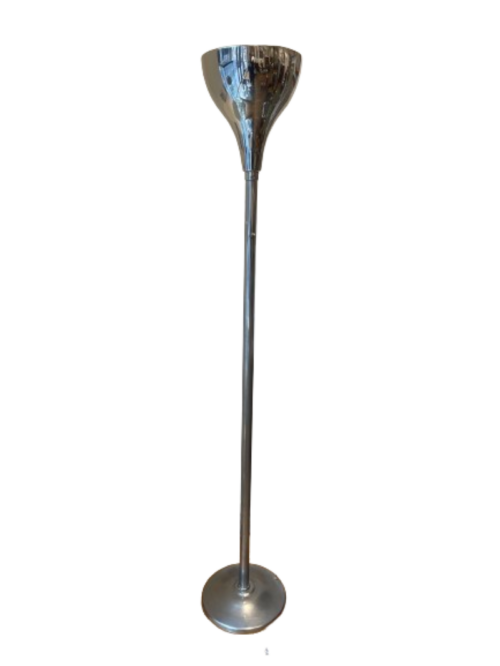-

 Lampadaire en métal chromé, icône du style moderniste, avec une vasque évasé reposant sur un fût cylindrique le tout maintenu par une base circulaire, Circa 1930. Bon état avec de légers enfoncements et traces d’oxydation. H : 1m72 Un exemplaire de ce lampadaire figurait dans l’aménagement de 1932 du Grand Salon de la Villa Cavrois (Croix). Robert MALLET-STEVENS(1886-1945) de 1904 à 1909, Il étudie l’architecture. Il devient un architecte majeur de la période art déco, appliquant un style moderniste à des constructions de prestige pour une clientèle fortunée (Rue MALLET STEVENS, Paris XVI, maison de martel à Boulogne, villa Cavrois). Ainsi que des bâtiment publique comme le célèbre casino de Saint-Jean-de-Luz. Emblématique du style « paquebot ». En 1929 il co-fonde l’Union des Artistes Modernes (UAM), et en 1935,Mallet-Stevens devient directeur de l’École des Beaux-Arts de Lille. Câblage aux standards européen. Modernist chrome lamp, Robert MALLET-STEVENS (1886-1945), circa 1930 Chromed metal floor lamp, icon of the modernist style, with a flared basin resting on a cylindrical barrel all maintained by a circular base, Circa 1930. Good condition with slight dents and traces of oxidation. H : 62.72 inches A copy of this floor lamp appeared in the 1932 layout of the Grand Salon of the Villa Cavrois (Croix). Robert MALLET-STEVENS (1886-1945) from 1904 to 1909, studied architecture. He became a major architect of the Art Deco period, applying a modernist style to prestigious constructions for a wealthy clientele (Rue MALLET STEVENS, Paris XVI, house of martel in Boulogne, villa Cavrois). As well as public buildings such as the famous casino of Saint-Jean-de-Luz. Emblematic of the "liner" style. In 1929 he co-founded the Union des Artistes Modernes (UAM), and in 1935, Mallet-Stevens became director of the Ecole des Beaux-Arts de Lille. Wide for european use.
Lampadaire en métal chromé, icône du style moderniste, avec une vasque évasé reposant sur un fût cylindrique le tout maintenu par une base circulaire, Circa 1930. Bon état avec de légers enfoncements et traces d’oxydation. H : 1m72 Un exemplaire de ce lampadaire figurait dans l’aménagement de 1932 du Grand Salon de la Villa Cavrois (Croix). Robert MALLET-STEVENS(1886-1945) de 1904 à 1909, Il étudie l’architecture. Il devient un architecte majeur de la période art déco, appliquant un style moderniste à des constructions de prestige pour une clientèle fortunée (Rue MALLET STEVENS, Paris XVI, maison de martel à Boulogne, villa Cavrois). Ainsi que des bâtiment publique comme le célèbre casino de Saint-Jean-de-Luz. Emblématique du style « paquebot ». En 1929 il co-fonde l’Union des Artistes Modernes (UAM), et en 1935,Mallet-Stevens devient directeur de l’École des Beaux-Arts de Lille. Câblage aux standards européen. Modernist chrome lamp, Robert MALLET-STEVENS (1886-1945), circa 1930 Chromed metal floor lamp, icon of the modernist style, with a flared basin resting on a cylindrical barrel all maintained by a circular base, Circa 1930. Good condition with slight dents and traces of oxidation. H : 62.72 inches A copy of this floor lamp appeared in the 1932 layout of the Grand Salon of the Villa Cavrois (Croix). Robert MALLET-STEVENS (1886-1945) from 1904 to 1909, studied architecture. He became a major architect of the Art Deco period, applying a modernist style to prestigious constructions for a wealthy clientele (Rue MALLET STEVENS, Paris XVI, house of martel in Boulogne, villa Cavrois). As well as public buildings such as the famous casino of Saint-Jean-de-Luz. Emblematic of the "liner" style. In 1929 he co-founded the Union des Artistes Modernes (UAM), and in 1935, Mallet-Stevens became director of the Ecole des Beaux-Arts de Lille. Wide for european use.